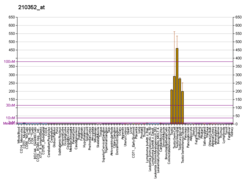BRD8
Bromodomain-containing protein 8 is a protein that in humans is encoded by the BRD8 gene.[5][6][7]
The protein encoded by this gene interacts with thyroid hormone receptor in a ligand-dependent manner and enhances thyroid hormone-dependent activation from thyroid response elements. This protein contains a bromodomain and is thought to be a nuclear receptor coactivator. Three alternatively spliced transcript variants that encode distinct isoforms have been identified.[7]
Interactions
BRD8 has been shown to interact with Thyroid hormone receptor beta[6] and Retinoid X receptor alpha.[8]
References
- 1 2 3 GRCh38: Ensembl release 89: ENSG00000112983 - Ensembl, May 2017
- 1 2 3 GRCm38: Ensembl release 89: ENSMUSG00000003778 - Ensembl, May 2017
- ↑ "Human PubMed Reference:".
- ↑ "Mouse PubMed Reference:".
- ↑ Nielsen MS, Petersen CM, Gliemann J, Madsen P (Jun 1996). "Cloning and sequencing of a human cDNA encoding a putative transcription factor containing a bromodomain". Biochim Biophys Acta. 1306 (1): 14–6. doi:10.1016/0167-4781(95)00239-1. PMID 8611617.
- 1 2 Monden T, Wondisford FE, Hollenberg AN (Dec 1997). "Isolation and characterization of a novel ligand-dependent thyroid hormone receptor-coactivating protein". J Biol Chem. 272 (47): 29834–41. doi:10.1074/jbc.272.47.29834. PMID 9368056.
- 1 2 "Entrez Gene: BRD8 bromodomain containing 8".
- ↑ Monden, T; Kishi M; Hosoya T; Satoh T; Wondisford F E; Hollenberg A N; Yamada M; Mori M (Oct 1999). "p120 acts as a specific coactivator for 9-cis-retinoic acid receptor (RXR) on peroxisome proliferator-activated receptor-gamma/RXR heterodimers". Mol. Endocrinol. UNITED STATES. 13 (10): 1695–703. doi:10.1210/me.13.10.1695. ISSN 0888-8809. PMID 10517671.
External links
- Human BRD8 genome location and BRD8 gene details page in the UCSC Genome Browser.
- Human SMAP2 genome location and SMAP2 gene details page in the UCSC Genome Browser.
Further reading
- Doyon Y, Côté J (2004). "The highly conserved and multifunctional NuA4 HAT complex". Curr. Opin. Genet. Dev. 14 (2): 147–54. doi:10.1016/j.gde.2004.02.009. PMID 15196461.
- Maruyama K, Sugano S (1994). "Oligo-capping: a simple method to replace the cap structure of eukaryotic mRNAs with oligoribonucleotides". Gene. 138 (1–2): 171–4. doi:10.1016/0378-1119(94)90802-8. PMID 8125298.
- Suzuki Y, Yoshitomo-Nakagawa K, Maruyama K, et al. (1997). "Construction and characterization of a full length-enriched and a 5'-end-enriched cDNA library". Gene. 200 (1–2): 149–56. doi:10.1016/S0378-1119(97)00411-3. PMID 9373149.
- Monden T, Kishi M, Hosoya T, et al. (1999). "p120 acts as a specific coactivator for 9-cis-retinoic acid receptor (RXR) on peroxisome proliferator-activated receptor-gamma/RXR heterodimers". Mol. Endocrinol. 13 (10): 1695–703. doi:10.1210/me.13.10.1695. PMID 10517671.
- Lai F, Godley LA, Joslin J, et al. (2001). "Transcript map and comparative analysis of the 1.5-Mb commonly deleted segment of human 5q31 in malignant myeloid diseases with a del(5q)". Genomics. 71 (2): 235–45. doi:10.1006/geno.2000.6414. PMID 11161817.
- Wiemann S, Weil B, Wellenreuther R, et al. (2001). "Toward a Catalog of Human Genes and Proteins: Sequencing and Analysis of 500 Novel Complete Protein Coding Human cDNAs". Genome Res. 11 (3): 422–35. doi:10.1101/gr.GR1547R. PMC 311072. PMID 11230166.
- Strausberg RL, Feingold EA, Grouse LH, et al. (2003). "Generation and initial analysis of more than 15,000 full-length human and mouse cDNA sequences". Proc. Natl. Acad. Sci. U.S.A. 99 (26): 16899–903. Bibcode:2002PNAS...9916899M. doi:10.1073/pnas.242603899. PMC 139241. PMID 12477932.
- Cai Y, Jin J, Tomomori-Sato C, et al. (2003). "Identification of new subunits of the multiprotein mammalian TRRAP/TIP60-containing histone acetyltransferase complex". J. Biol. Chem. 278 (44): 42733–6. doi:10.1074/jbc.C300389200. PMID 12963728.
- Doyon Y, Selleck W, Lane WS, et al. (2004). "Structural and Functional Conservation of the NuA4 Histone Acetyltransferase Complex from Yeast to Humans". Mol. Cell. Biol. 24 (5): 1884–96. doi:10.1128/MCB.24.5.1884-1896.2004. PMC 350560. PMID 14966270.
- Beausoleil SA, Jedrychowski M, Schwartz D, et al. (2004). "Large-scale characterization of HeLa cell nuclear phosphoproteins". Proc. Natl. Acad. Sci. U.S.A. 101 (33): 12130–5. Bibcode:2004PNAS..10112130B. doi:10.1073/pnas.0404720101. PMC 514446. PMID 15302935.
- Gerhard DS, Wagner L, Feingold EA, et al. (2004). "The Status, Quality, and Expansion of the NIH Full-Length cDNA Project: The Mammalian Gene Collection (MGC)". Genome Res. 14 (10B): 2121–7. doi:10.1101/gr.2596504. PMC 528928. PMID 15489334.
- Cai Y, Jin J, Florens L, et al. (2005). "The mammalian YL1 protein is a shared subunit of the TRRAP/TIP60 histone acetyltransferase and SRCAP complexes". J. Biol. Chem. 280 (14): 13665–70. doi:10.1074/jbc.M500001200. PMID 15647280.
- Benevolenskaya EV, Murray HL, Branton P, et al. (2005). "Binding of pRB to the PHD protein RBP2 promotes cellular differentiation". Mol. Cell. 18 (6): 623–35. doi:10.1016/j.molcel.2005.05.012. PMID 15949438.
- Rual JF, Venkatesan K, Hao T, et al. (2005). "Towards a proteome-scale map of the human protein-protein interaction network". Nature. 437 (7062): 1173–8. Bibcode:2005Natur.437.1173R. doi:10.1038/nature04209. PMID 16189514.
- Natsume W, Tanabe K, Kon S, et al. (2006). "SMAP2, a Novel ARF GTPase-activating Protein, Interacts with Clathrin and Clathrin Assembly Protein and Functions on the AP-1–positive Early Endosome/Trans-Golgi Network". Mol. Biol. Cell. 17 (6): 2592–603. doi:10.1091/mbc.E05-10-0909. PMC 1475504. PMID 16571680.
- Beausoleil SA, Villén J, Gerber SA, et al. (2006). "A probability-based approach for high-throughput protein phosphorylation analysis and site localization". Nat. Biotechnol. 24 (10): 1285–92. doi:10.1038/nbt1240. PMID 16964243.
- Olsen JV, Blagoev B, Gnad F, et al. (2006). "Global, in vivo, and site-specific phosphorylation dynamics in signaling networks". Cell. 127 (3): 635–48. doi:10.1016/j.cell.2006.09.026. PMID 17081983.
This article is issued from
Wikipedia.
The text is licensed under Creative Commons - Attribution - Sharealike.
Additional terms may apply for the media files.





